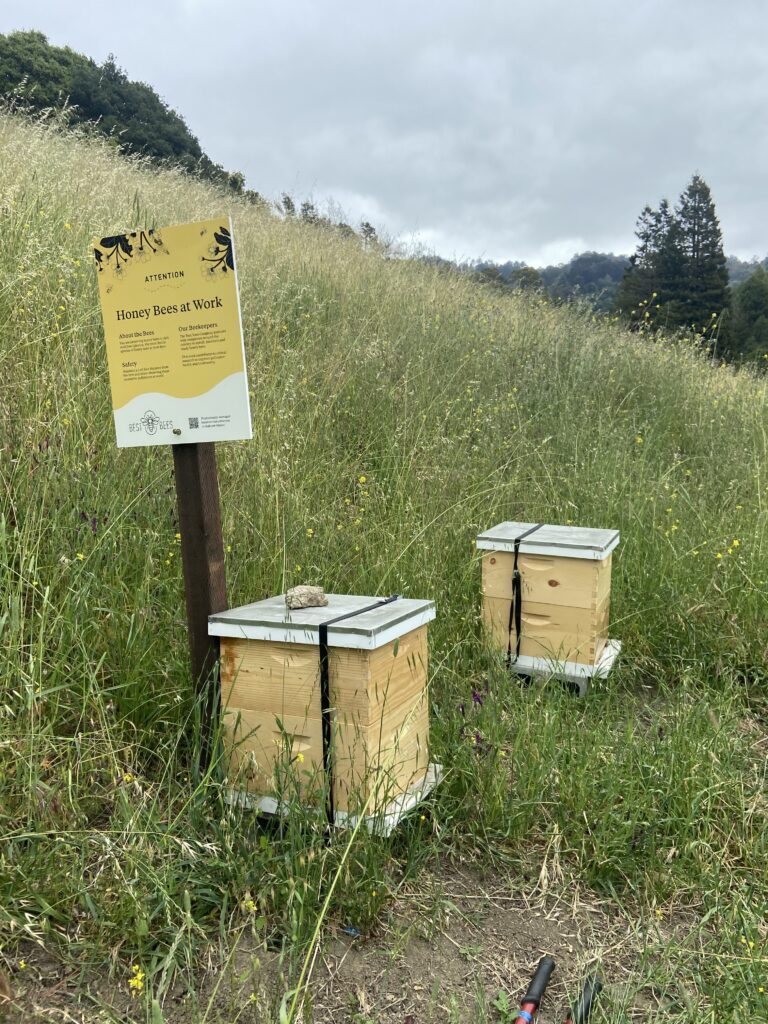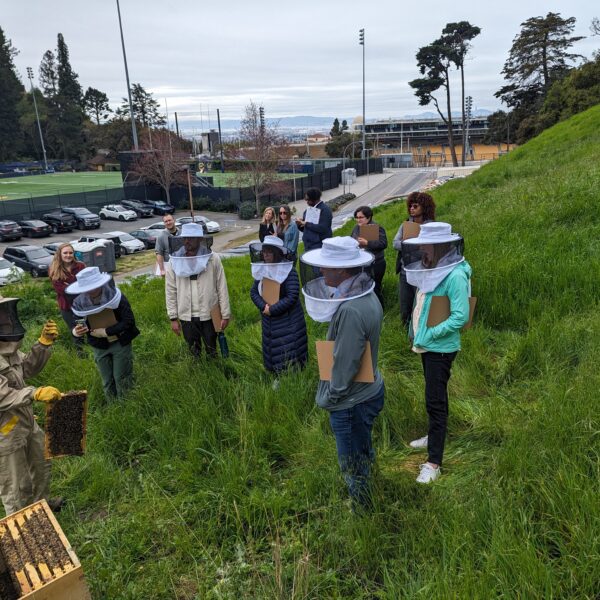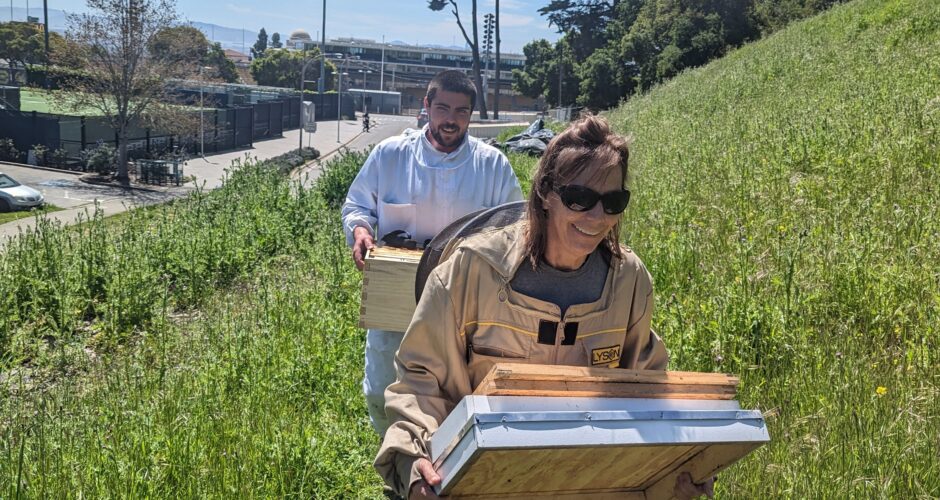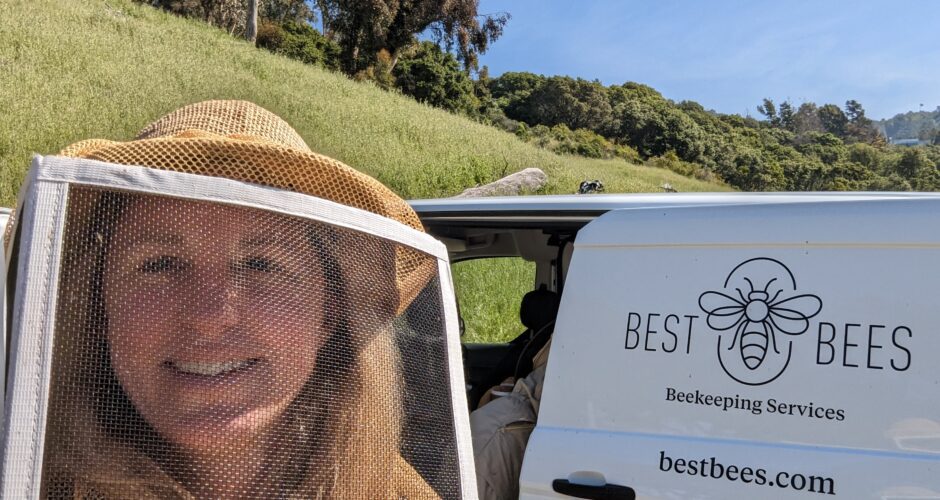Berkeley Haas, in collaboration with the TGIF, have the first formally established hives on the Berkeley campus!

The two Italian honey bee hives are located on the north side of Centennial Road across the street from the CAL Rugby and Softball fields. Haas is partnering with Best Bees Co., a non-profit, that has provided the hives and bees.
Hive Updates
Our beekeepers come every couple of weeks to manage the hive’s health!
In your right hive, specifically, the queen is healthy and laying, the brood pattern looks good, but there just doesn’t seem to be a large worker population. What population is there looks healthy, but we want to give them a little population boost, so we will be bringing some additional brood and bees to introduce to your hive. This should be all they need to get back to thriving!
Looks like your right hive colony recently swarmed!
We take measures to try to prevent hives from swarming, but it is in the nature of honey bees to do so. It’s a real nature versus nurture conundrum, and this time, nature won. But don’t worry, your colony is just fine! This is actually a sign of a healthy thriving hive. The bees that stayed behind are now enjoying the increased space in their hive and all the extra leg room.
It looks like your left hive is on verge of swarming as well, but we will try to split the colony before this happens so we can give the bees a home without them going out looking for one themselves.
When a honey bee colony outgrows its home, becomes too congested, or too populated for the queen’s pheromones to control the entire workforce, the workers signal that it is time to swarm. They will build new queen cells, which the queen will lay eggs in. She then will stop laying eggs, and reduce her weight so she is able to fly and lead half of the colony out of the hive in search of a new home.
The queens developing in the swarm cells in the old hive are attended by the bees that did not leave with the old queen. In 16 days, the new queens will begin to emerge. We will be back to check in on these lovely ladies, and the rest of your colony, soon!
Checking back in! We are happy to report that on our recent visit, our beekeeper found that both of your colonies are alive and well!
Your beekeeper, Lars, stopped by to say hi to the bees and make sure that they have enough to eat. If it’s been rainy, the bees wouldn’t have been able to fly as far to forage for pollen and nectar. Their fuzzy bodies get weighed down with water, and it requires more energy to fly!
Your colony’s foragers have been working hard, it seems, and your hive is looking good. Lars described them as “extremely active.” We’ll see you and your busy beesnext time!
It sounds like the Hive Tour was a fun and successful experience! Lars noted that they were able to show off the queen bee, and frames of healthy brood, pollen, and honey! The Right Hive has a lot of excellent resources stored and ready to feed the bees through the winter.
While there, Lars also check on the Left Hive. The queen-right combo has been incorporated beautifully into the hive and the queen seems to be very happy. She’s busy maintaining a robust population in her new home. The ladies are hard at work raising the brood and collecting the last of the forage.
We’ll be back again soon to check on them!
Lars visited this week to install a queen-right combo into the Left Hive. They had gone queenless and dwindled, so we brought them a new queen and a happy lot of bees. We also brought several of their built-out frames from the hive they were living in at our apiary. This way they can continue to raise brood, and store honey. Lars made sure they have room to grow, and sturdy frames to fill with important resources.
While he was there, Lars noticed that the Right Hive had absconded. “Absconding” is when the colony has left their hive for a new home.
Absconsions are hard to control, even when an ideal environment is provided by the beekeepers. Frequently, a hive will abscond due to factors outside of human control, such as pesticide exposure, air quality, predator activity, or they simply found a desirable spot elsewhere.
The whole colony makes the decision to abscond together; it’s a very democratic process, like a town hall meeting. Unfortunately, we humans were not invited to cast our vote.
Lars will come out on Tuesday morning, October 17th, to replace your colony with a new colony from one of our research apiaries. The bees are happy, healthy, and ready to settle into their new home.
Every colony has a different personality and capacity for a given environment. Regardless, we will keep a careful eye on your new colony to monitor their response to their new hive.
Thank you for your continued support and contribution to our mission of protecting and promoting pollinator health! Feel free to ask all kinds of questions about it in the upcoming tour!
Exciting news! The beekeepers were able to take a honey harvest from the Right Hive! As we discussed in August, first year hives don’t typically yield a harvest. But the ladies in the Right Hive have worked so hard, and put away more than enough honey for a comfortable winter survival.
Harvesting honey is a delicate balance for us here at Best Bees. Honey is the bees’ food – it’s their source of carbohydrates; they need to have a sufficient amount of honey stored to get them through the winter.
We only harvest the excess if a hive has been producing an abundance of honey. Beekeepers always assess the hive to make sure that, if they were to harvest, there would still be multiple frames of honey left in the hive.
The health of the bees is our priority, so if a hive can’t spare the honey, we don’t harvest. But don’t worry! If your hive needs all of its honey, you’ll receive jars of our Special Reserve honey as part of your honey guarantee.
Enjoy your sweet honey, knowing that it was ethically and sustainably harvested.
Your friendly neighborhood beekeepers here, just touching base after our last visit to your site! All seems to be running smoothly; both of your colonies are in excellent shape. The beekeeper added a box to the Left Hive to make room for their growing population, and influx of important resources!
Our mission at Best Bees has been to improve bee health since Day 1. But how does managing a national network of data-yielding honey bee hives help native bees, you might ask?
Well, one way is to leverage honey bees as an indicator species. An indicator species, also known as a bioindicator, is one that reflects the condition of the environment around it. To be an effective bioindicator, a species should have a population big enough to easily study, and it has to respond to changes in a measurable way.
Of the roughly 3,600 species of bees in North America, more than 90 percent are solitary in nature. This makes continuously monitoring and studying them an almost impossible task.
Honey bees, on the other hand, are very easily managed and studied. Working together as a whole unit, honey bee colonies, while at risk, are resilient to the many environmental stressors they face. This allows for long-term monitoring, which means we can map environmental changes in an area as well as study trends over time.
Your Right Hive briefly was without a queen bee, but not to worry — your colony has a new queen in charge!
Our beekeepers came prepared with a combo — frames that contain a queen bee, brood, larvae, and worker bees — to be added to your hive. The old and the new bees are separated by a layer of newspaper to keep the new queen safe while the bees get used to each other’s pheromones. The top is propped to give the bees in the top box an entrance and exit.
The bees have to tear through the paper before they can interact, and this process takes them some time, allowing the pheromones to mingle. By the time the new and old bees can pass through the paper, they will have accepted each other as their own.
The days are longer, the flowers are blooming, and our favorite, the bees are buzzing!
On our recent visit, your beekeepers were able to get inside the hives and conduct a full check. They examined frames to look at the queen bee’s egg laying pattern, checked on their food stores, and observed their beeswax production.
Everything looked to be in tip-top shape! The hives were neat as a pin – did you know that honey bees never use the bathroom inside their hive? Instead, they take what is called a “cleansing flight.” In addition to keeping the hive clean, this activity allows the housebound worker bees to stretch their wings and exercise their flight muscles.
On our visit last week, the beekeeper inspected both hives, and thoroughly checked to make sure that none of the recent tampering has hurt the colonies. Both colonies are healthy and continuing to grow, though the right one is a little bit smaller than the left. The ants had invaded the top box, interested in the feeder full of sugar water. The beekeeper replaced the top box with a fresh one, and took the feeder away. The bees have been collecting resources from local forage, so the sugar water is unnecessary for now. The beekeeper also installed an ant trap to collect any future ant visitors.
The bees are okay, and both queens are laying fresh eggs. We will continue to monitor their health and growth.
On their recent visit, the beekeepers checked on the populations in both hives. In the beekeepers’ words, the colonies are “small but hardy!”
It looks like the queens in both hives were off to slow starts, but their productivity has ramped up recently. Perhaps they were wary to get started, and took their time getting comfortable, but it’s evident now that both queens are laying eggs at a much improved rate. The frames of eggs and days old brood in the hives have doubled, and the population will soon reflect this! The beekeepers look to the shape and pattern of the queen’s egg-laying to come to conclusions about her health. The queens in both hives are laying in gorgeous rainbow patterns, a very good sign of wellness.
On their visit on the 5th the beekeepers noticed that the left hive had been tampered with. The strap was taken off, and the lid was askew. The bees were totally fine inside, and we’ll keep tabs on whether or not this happens again. I’ll keep you posted with follow up notes!
While there, the beekeepers added boxes to the hives! This gives the bees more room for their expanding populations. Both colonies are healthy and growing. The queens are active and laying eggs. The forager ladies are out and about, coming back to the hive with brightly colored “pollen pants.”
On Friday, the beekeepers were able to successfully install the bees in their new homes!
You may notice your bees flying around their hives in a figure-eight pattern; this is their orientation flight, a technique used to get comfortable in their new home. This activity will only last for a few days – bees are quick learners!
We’re so glad you decided to join us on our mission to improve bee health. The research we do, partnered with property owners like you, helps us to save the beesand other native pollinators. This, in turn, protects the global food supply, contributes to cleaner air through carbon cycling, and supports biodiversity.
Pollinator Garden
Haas received an additional grant from TGIF to create a pollinator garden on the east side of the faculty building. Bees and other pollinators contribute to local biodiversity by pollinating different flowers, crops, and trees, propagating them in our UC Berkeley environment. The more biodiversity, i.e., the number of species in an ecosystem, the healthier the ecosystem. Biodiversity, in turn, supports healthier food systems and increases nutritional diversity and security. Hosting beehives on site expands local pollinator habitat and can also contribute to our local social sustainability by enhancing the quality of life and reducing stress. Beehives are a pillar of the environment, and hosting them for scientific research can improve our understanding of climate impacts on our environment.
We had student artists research, conceptualize, design and build a structure that would attract and support native bees and other pollinators. The structure tells a story, educates our community and ties the Haas pollinator garden to the Haas Hives. The team used recycled glass and local materials to create the installation! Be sure to check it out!






